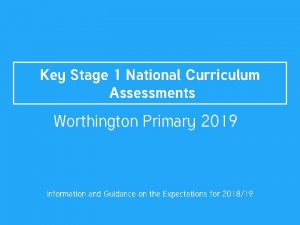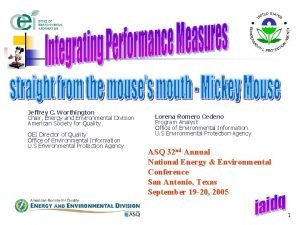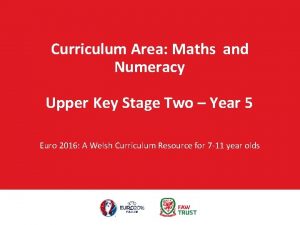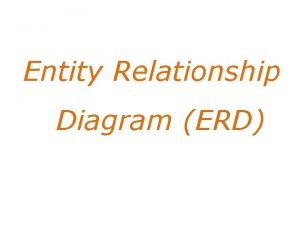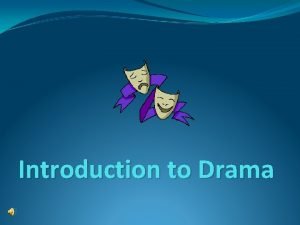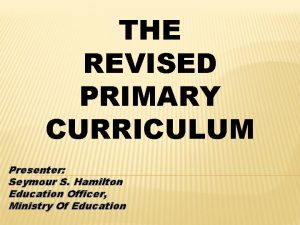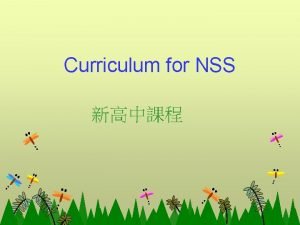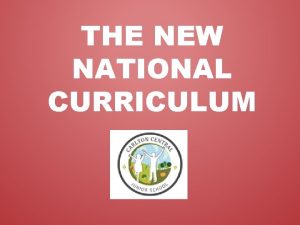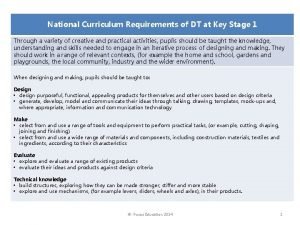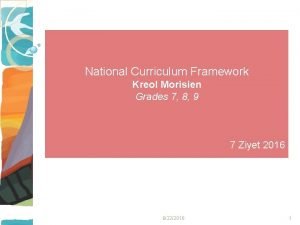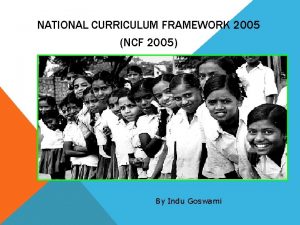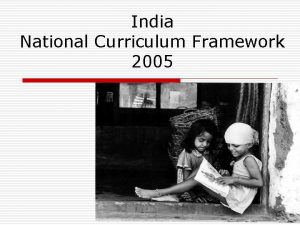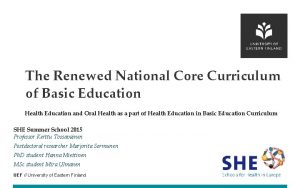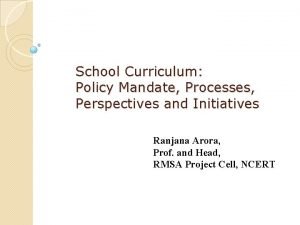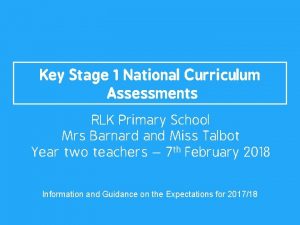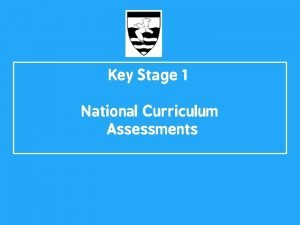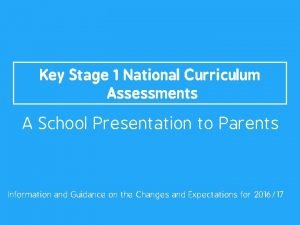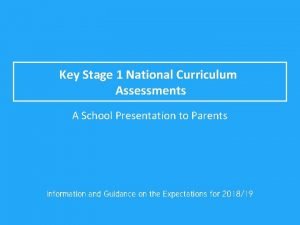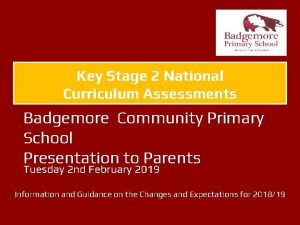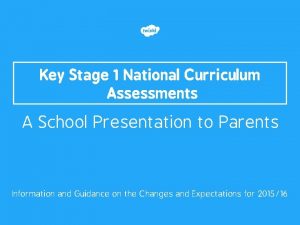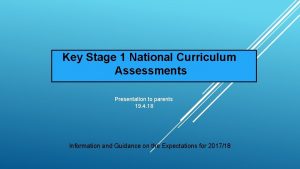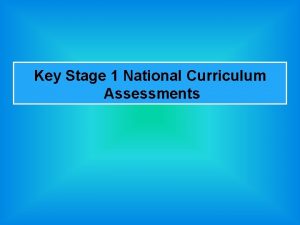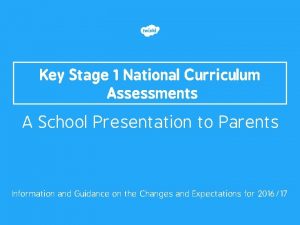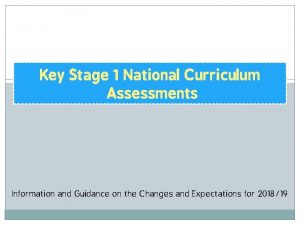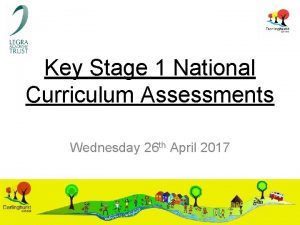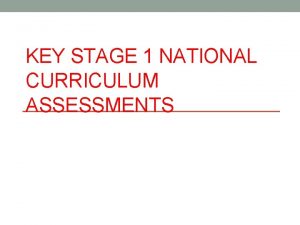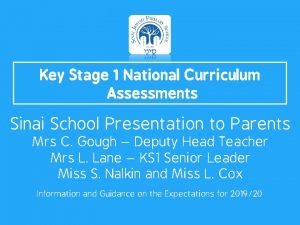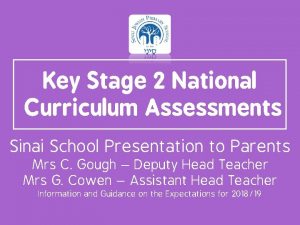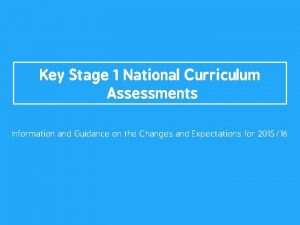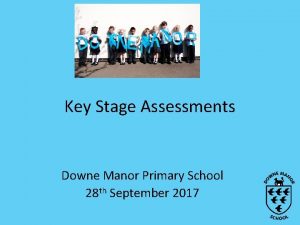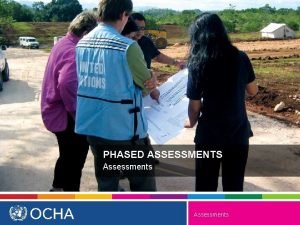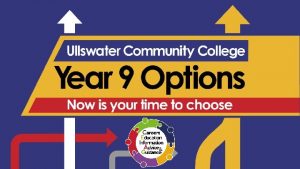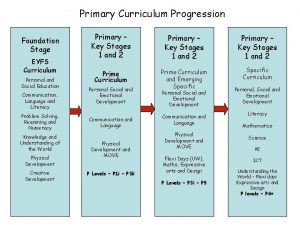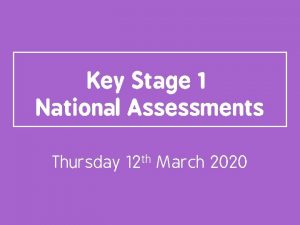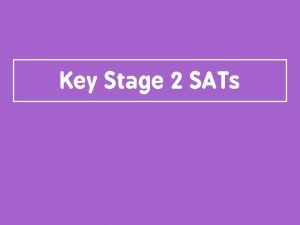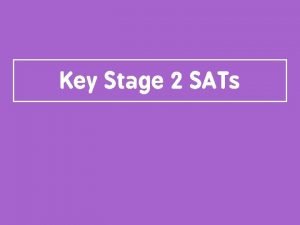Key Stage 1 National Curriculum Assessments Worthington Primary


























- Slides: 26

Key Stage 1 National Curriculum Assessments Worthington Primary 2019 Information and Guidance on the Expectations for 2018/19

Chapters Key Stage 1 National Curriculum Assessments Assessment and Reporting Scaled Scores Scaled Score Examples The SAT Assessments English Maths How to Help Your Child next page

Key Stage 1 National Curriculum Assessments click to see all text • In 2014, a new national curriculum framework was introduced by the Government for Years 1, 3, 4 and 5. However, Years 2 and 6 (due to statutory testing) continued to study the previous curriculum for one further year. • However, in 2015/2016, children in Year 2 and Year 6 were also expected to study the new national curriculum. • In the summer of 2016, KS 1 (Year 2) and KS 2 SATs (Year 6) reflected the new curriculum for the first time. • This will be the fourth secondyearthatthe thenew newcurriculumisiscoveredwithin. SATassessments. chapter menu next page

Assessment and Reporting click to see all text • In recent years, ‘old’ national curriculum levels (e. g. Levels 1, 2, 3) have been abolished as set out in the government guidelines. Children are now described as working towards, working at and working at greater depth according to the Year 2 expectations of the new curriculum. (ARE). Science is reported as Expected/not Expected. • The new curriculum is more rigorous and sets high expectations, which all schools have had to work hard to meet in the last two years. • Assessment As of 2016, test at the scores end of are. KS 1 nowconsists reported ofas statutory ‘scaled scores’. tests (activity) which help inform teacher assessment. Alongside the tests teachers have an Interim Framework for Science, Reading, Writing and Maths which they use to make an accurate judgement on your child’s progress against the Age Related Expectations (ARE). Teacher assessment and results of the tests are reported at the end of the year in your child’s report. The tests are reported as a scaled score. chapter menu next page

Scaled Scores click to see all text What is meant by ‘scaled scores’? • It is planned that 100 will always represent the ‘national standard’. • Each pupil’s raw test score will therefore be converted into a score on the scale, either at, above or below 100. • The scale will have a lower end point somewhere below 100 and an upper end point above 100. • A child who achieves the ‘national standard’ (a score of 100) will be judged to have demonstrated sufficient knowledge in the areas assessed by the tests. chapter menu next page

Scaled Score Examples click to see all text On publication of the test results in July 2019: 2017: • A child awarded a scaled score of 100 is judged to have met the ‘national standard’ in the area judged by the test. • A child awarded a scaled score of more than 100 is judged to have exceeded the national standard and demonstrated a higher than expected knowledge of the curriculum for their age. • A child awarded a scaled score of less than 100 is judged to have not yet met the national standard and performed below expectation for their age. • Marking guidance for KS 1 tests will include conversion tables. Teachers will use these to translate pupil’s raw scores into scaled scores to see whether each pupil has met the national standard. Teachers will use the scaled scores to inform their teacher assessment judgements. chapter menu next page

The SAT Assessments click to see all text At the end of Year 2, children will take assessments in: • Reading • Maths Grammar, Your child’s. Punctuation school mayand also. Spelling decide SAT to administer assessment theisoptional not compulsory English: Grammar, however we do use it Punctuation sometimesand as part Spelling of our SAT own assessment teacher assessments. in order to inform their teacher-assessed level in Writing. All assessment are due to take place in May this year. Please do not take any holidays during All assessment this time. are due to take place in May this year. • Writing is assessed entirely by the class teacher using the Interim Framework through your child’s written work in class. • • • https: //www. gov. uk/government/publications/teacher-assessment-frameworks-at-the-end-of-key-stage-1 https: //www. gov. uk/government/publications/teacher-assessment-exemplification-ks 1 -science https: //www. gov. uk/government/publications/2018 -teacher-assessment-exemplification-ks 1 -english-writing https: //www. gov. uk/government/publications/teacher-assessment-exemplification-ks 1 -mathematics https: //www. gov. uk/guidance/teacher-assessment-exemplification-ks 1 -english-reading chapter menu next page

click to see all text Reading The Reading Test consists of two separate papers: • Paper 1 – consists of a combined reading prompt and answer booklet. The paper includes a list of useful words and some practice questions for teachers to use to introduce the contexts and question types to pupils. The test takes approximately 30 minutes to complete, but is not strictly timed. • Paper 2 – consists of an answer booklet and a separate reading booklet. There are no practice questions on this paper. Teachers can use their discretion to stop the test early if a pupil is struggling. The test takes approximately 40 minutes to complete, but is not strictly timed. • The texts will cover a range of poetry, fiction and non-fiction. Every year, SATs are completed in a very reassuring, non-threatening way to ensure the children achieve their potential. Groups and timing are carefully designed to suit the children. chapter menu next page

Reading: Sample Questions are designed to assess the comprehension and understanding of a child’s reading. There a variety of question types: Multiple Choice chapter menu next page

Reading: Sample Questions Ranking/Ordering chapter menu next page

Reading: Sample Questions Matching/Labelling Short-Answer Questions chapter menu next page

Reading: Sample Questions click to see all text Find and Copy Questions Open-Ended Questions chapter menu next page

Spelling, Punctuation and Grammar This year, the Spelling, Punctuation and Grammar test will be optional for all Year 2 classes. Your child’s school may still administer the assessment in order to inform their teacherassessed writing judgements. The test consists of two separate papers: • Paper 1: Spelling - pupils to spell 20 missing words within a test booklet. The test is expected to take approximately 15 minutes to complete, but is not strictly timed. • Paper 2: Grammar, Punctuation and Vocabulary - a combined question and answer booklet focusing on pupils’ knowledge of grammar, punctuation and vocabulary. Pupils will have approximately 20 minutes to complete the questions in the test paper, but it is not strictly timed. chapter menu next page

Grammar, Punctuation & Spelling: Sample Questions Grammar, Punctuation and Vocabulary Paper chapter menu next page

Grammar, Punctuation & Spelling: Sample Questions Grammar, Punctuation and Vocabulary Paper chapter menu next page

Grammar, Punctuation & Spelling: Sample Questions Spelling Paper Within the assessment, the spelling words are read out to the children to fill into the gaps within the sentences. In this example, the missing spelling words are: pack, sky, shell and baby. chapter menu next page

Mathematics Children will sit two tests: Paper 1 and Paper 2: • Paper 1: Arithmetic - lasts approximately 20 minutes (but this is not strictly timed). It covers calculation methods for all operations. • Paper 2: Reasoning - lasts for approximately 35 minutes, which includes time for five aural questions. Pupils will still require calculation skills and questions will be varied including multiple choice, matching, true/false, completing a chart or table or drawing a shape. Some questions will also require children to show or explain their working out. Every year, SATs are completed in a very reassuring, nonthreatening way to ensure the children achieve their potential. Groups and timing are carefully designed to suit the children. chapter menu next page

Mathe: Sample Questions Maths Paper 1: Arithmetic chapter menu next page

Maths: Sample Questions Maths Paper 2: Reasoning chapter menu next page

Maths: Sample Questions Maths Paper 2: Reasoning chapter menu next page

click to see all text How to Help Your Child • First and foremost, support and reassure your child that there is nothing to worry about and that they should always just try their best. Praise and encourage! • Ensure your child has the best possible attendance at school. • Support your child with any homework tasks. • Reading, spelling and arithmetic (e. g. times tables) are always good to practise. • Talk to your child about what they have learnt at school and what book(s) they are reading (the character, the plot, their opinion). • Make sure your child has a good sleep and healthy breakfast every morning! chapter menu next page

How to Help Your Child with Reading click to see all text Listening to your child read can take many forms: • First and foremost, focus developing an enjoyment and love of reading. • Enjoy stories together – reading stories to your child is equally as important as listening to your child read. • Read a little at a time but often, rather than rarely but for long periods of time! • Talk about the story before, during and afterwards – discuss the plot, the characters, their feelings and actions, how it makes you feel, predict what will happen and encourage your child to have their own opinions. • Look up definitions of words together – you could use a dictionary, the Internet or an app on a phone or tablet. • All reading is valuable – it doesn’t have to be just stories. Reading can involve anything from fiction and non-fiction, poetry, newspapers, magazines, football programmes, TV guides. • Visit the local library - it’s free! chapter menu next page

How to Help Your Child with Writing click to see all text • Practise and learn weekly spelling lists – make it fun! • Encourage opportunities for writing, such as letters to family or friends, shopping lists, notes or reminders, stories or poems. • Write together – be a good role model for writing. • Encourage use of a dictionary to check spelling. • Allow your child to use a computer for word processing, which will allow for editing and correcting of errors without lots of crossing out. • Remember that good readers become good writers! Identify good writing features when reading (e. g. vocabulary, sentence structure, punctuation). • Show your appreciation: praise and encourage, even for small successes! chapter menu next page

How to Help Your Child with Maths click to see all text • Play times tables games. • Play mental maths games including counting in different amounts, forwards and backwards. • Encourage opportunities for telling the time. • Encourage opportunities for counting coins and money e. g. finding amounts or calculating change when shopping. • Look for numbers on street signs, car registrations and anywhere else. • Look for examples of 2 D and 3 D shapes around the home. • Identify, weigh or measure quantities and amounts in the kitchen or in recipes. • Play games involving numbers or logic, such as dominoes, card games, draughts or chess. chapter menu next page

How we are helping your child to prepare click to see all text • Play times tables games. Quality first teaching throughout KS 1. Play mental maths games counting on in different amounts, forwards and Ongoing assessment to including ensure progress a daily basis. backwards. Ongoing review of individual targets. Flexibility in groupings – whole class preparation, small group booster • Encourage opportunities for telling the time. sessions, peer reading to develop fluency. • • Encourage Reassurance and praise to boost confidence. opportunities for counting coins and money e. g. finding amounts or calculating • • • change when shopping. End of Year 2 assessments onlycar one part of ourand assessments of your child’s • Look for numbers on streetare signs, registrations anywhere else. learning and progress throughout KS 1. • Look for examples of 2 D and 3 D shapes around the home. • Identify, weigh or measure quantities and amounts in the kitchen or in recipes. • Play games involving numbers or logic, such as dominoes, card games, draughts or chess. chapter menu next page

 Worthington primary school
Worthington primary school Joe budington lacrosse
Joe budington lacrosse Worthington stool
Worthington stool Ted worthington
Ted worthington Upper key stage 2 maths
Upper key stage 2 maths Entity relationship adalah
Entity relationship adalah Revenue streams example business model canvas
Revenue streams example business model canvas Contoh bisnis model canvas makanan pdf
Contoh bisnis model canvas makanan pdf Stage 1: denial
Stage 1: denial Stage right stage left diagram
Stage right stage left diagram Thrust stage
Thrust stage What is two stage tendering
What is two stage tendering Stage right stage left
Stage right stage left Stage left vs stage right
Stage left vs stage right Knowledge harvest ipc
Knowledge harvest ipc Revised primary curriculum grade 1-3
Revised primary curriculum grade 1-3 Primary care practice facilitation curriculum
Primary care practice facilitation curriculum Chinese national curriculum core subjects
Chinese national curriculum core subjects Non statutory subjects national curriculum
Non statutory subjects national curriculum Dt national curriculum
Dt national curriculum Dance in the national curriculum
Dance in the national curriculum Tradiksio
Tradiksio Introduction of ncf 2005
Introduction of ncf 2005 National curriculum framework 2005
National curriculum framework 2005 National core curriculum
National core curriculum Recommendations of ncf 2005
Recommendations of ncf 2005 Ncs curriculum
Ncs curriculum
